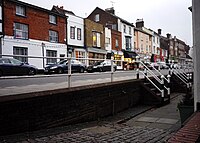Hemel Hempstead
Hemel Hempstead is a town in England. It is 25 miles north-west of London. The town is off the M1 motorway, 20 minutes drive from Luton Airport and 40 minutes from London itself.


History
changeThe town began as an Anglo Saxon village where two river valleys met in the Chiltern Hills. The local area grew very good grain. By Tudor times, the village became a market where grain and straw were sold. The town also had many water mills to grind the grain. Local people also earned money by plaiting the straw to be made into hats.
From about 1800, the town changed as the Industrial revolution took place. It is on the shortest route between London and the Birmingham. As trade between these two cities increased, a canal and a railway were built that passed very close to the town. Some of its water mills were changed from grinding grain to places where paper was made by machine. Some of these grew into giant paper making factories.
After the Second World War, the government in London wanted to build many new homes for people who had had their homes destroyed by bombs in the war. It decided to build some new towns where houses could be built in an very good environment. Hemel Hempstead was chosen to be one of these towns. Many new districts were built during the 1950s and 1960s all around the old town of Hemel Hempstead. It grew into a middle size town of over 80,000 people.
Many new industries came to the town helped by money from the government and because it is where important motorways cross each other.
Hemel Hempstead became world famous for a brief time in 2005 when an oil depot in the town at Buncefield exploded. It caused a big toxic smoke cloud to cover all the surrounding areas. Millions of pounds in damage was done, but no one was killed.